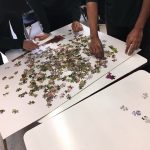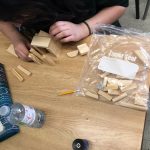If students are provided with the opportunity to work on a cascade of problems stemming from an overarching learning goal through various strategies including parallel tasks and accountable talk, then the students will be motivated to express and demonstrate their understanding at their own pace while cultivating their growth mindset. Overarching learning goals encompass essential knowledge and skills students must develop by the end of the course. Overarching learning goals also help provide context to the unit, and a way for students to reflect on o learning as they gather new information and skills. The teachers who engage in improving the mindset of students will build professional capacity by sharing their learning with the members of the math department, and will become peer mentors to the teachers who are interested in incorporating these tools into their classroom practice.
Team Members
Induja Mahathantila
Peel District School Board
Audrey McKitterick
Peel District School Board
Maureen Quatrociocchi
Peel District School Board
Maria Mah
Peel District School Board
Professional Learning Goals
- Explored strategies for teaching fractions in Grade 9 math classes to improve students’ number sense
- Re-enforced our understanding of “7 Norms of Positive Classrooms” and established concrete ways to embed them into our practice to develop growth mindset in our Grade 9 students
- Widened the range of activities that incorporated the use of manipulatives in various aspects of our classroom practices and routines
Activities and Resources
- Read Jo Boaler’s Mathematical Mindsets: Unleashing Students’ Potential Through Creative Math, Inspiring Messages and Innovative Teaching book, created posters of the seven norms to display them in the classroom and continued to refer to the norms on a daily basis
- Crafted overarching learning goals on linear relations and number sense units
- Designed opportunities to develop problem-solving, but also to fill the missing gaps in their previous learning
- Designed classroom activities that incorporated manipulatives that deepen student understanding of number sense, in particular fractions
- Examined student work (i.e., on erasable reusable worksheets and whiteboard desktops) demonstrating problem-solving and looked for ways to provide meaningful feedback to students
- Planned the use of structured breaks during class time to promote collaboration and build community in a safe learning-focused environment (i.e., use of jigsaw puzzles, playing cards, colouring books, problem-solving games, play dough, etc.)
- Check-in meetings as a group once a month to assess the progress and evaluate the successes of each strategy in every unit
- Provide feedback and support to each other throughout the learning journey
Unexpected Challenges
- Time challenges prevented the administration of the student engagement survey at the start of the semester and the use of technology to capture student work during the semester
- Was unable to structure in certain assessments as learning opportunities (i.e., video think alouds) as we had hoped
Enhancing Student Learning and Development
Students often harbour negative feelings towards learning math and are afraid to challenge themselves. The primary motivation of this project is to re-introduce curiosity about mathematics to our students, develop their passion for approaching math, and foster their growth mindset.
The overarching learning goals will be built from the three main strands (Number Sense and Algebra, Measurement, and Geometry and Linear Relations) where the Grade 9 students in the last four years have demonstrated the lowest level of achievement on the EQAO Grade 9 Math Assessment. Providing the opportunity to approach these topics utilizing different styles and actively engaging students in mathematical problem-solving throughout these units will break the barriers students face in developing and exploring ideas, and improve their mathematical reasoning skills.
Further motivations for this project are to increase student confidence, fill gaps in their prerequisite learning by providing them with the time they need to master those skills, and improve accountability for their learning.
Sharing
- Build capacity of the other members of the math department
- Share our strategies and learning by becoming a peer mentor to one or more teachers in the department
- Build further capacity in the school by sharing the tools developed in this learning with all teachers in the school during numeracy-focused professional learning days
Project Evaluation
- Informal conversations with students along with student achievement in each unit summative have demonstrated an improvement in student performance in mathematics
- Our anecdotal notes and reflections have indicated that students are feeling more confident and positive towards mathematics in Grade 9
- Based on the results from the post student survey on engagement as well as community-building activities, teachers that students are shifting from fixed mindset to a growth mindset
- Teachers deepened their understanding of number sense and increased their repertoire of strategies to teach fractions as a result of the exploration of “Paying Attention to Fractions” monograph and Kyle Pearce’s blog on fractions
Resources Created
These resources will open in your browser in a new tab, or be downloaded to your computer.



